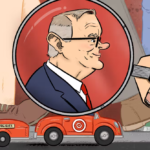Relationships can make or break us. So how are young people learning them?
The quality of young people’s future is dependent on their understanding what is involved in building healthy relationships in all aspects of their lives. Sue Roffey says this needs to be part of learning in every school and across every age group.
Not every young person will become a lawyer, doctor or banker so not everyone needs high test scores – but all of us need to know how to establish and maintain healthy relationships. Relationships – at home, at work and at school – are the lynchpin of our wellbeing. A bad relationship undermines a positive sense of self and a supportive one enhances life in many ways.
In a survey on wellbeing in schools in 2011 one respondent said ‘we do have some students who need more help with reading but we do not have a literacy crisis in Australia so much a relationship one’. Statistics give credence to this view. The media also regularly embeds negativity into our lives, both in the stories that get coverage but also in the models that constantly bombard us. Uncontrolled, irresponsible and disrespectful behaviour is considered ‘more interesting’ and over time this impacts on what is seen as normal.
So what can be done in education to counter this? As feelings are such a big component of relationships, social and emotional learning (SEL) go hand in hand. Research shows that SEL not only enhances pro-social behaviour, it also improves academic outcomes.
But how do you go about teaching such a personal subject? Giving information alone is unlikely to embed new behaviours, and without the right approach SEL risks becoming group therapy. No teacher wants to open a can of worms they do not feel competent to deal with!
Circle Solutions is a framework for teaching SEL based on the ASPIRE principles. This has been developed over many years and ensures that the pedagogy is appropriate for the subject matter and has effective outcomes. This is what this means in practice:
Agency: Rather than tell students what to do and think, Circles provide opportunities for young people to take responsibility for the emotional climate of their class. Activities such as devising a recipe for a safe and friendly classroom or using role play to imagine how someone might feel if they were excluded, encourages students to take action.
Safety: In Circles students work in pairs, small groups or the whole Circle to discuss issues, never incidents. The use of the third person and discussing commonalities ensures that no one is put on the spot. If someone chooses to stay silent and ‘pass’, that is fine. They contribute when they feel confident and have something to say.
Positivity: Much of what we know about resilience and wellbeing is found in the burgeoning research in positive psychology. Circle Solutions is a strengths and solution centred framework, so the focus is not on problems to eliminate, but how we want things to be. Circles need to happen regularly, so solutions are constructed by students over time and put into practice. Positive emotions are actively generated in Circles because 1) these open cognitive pathways to creative thinking and 2) laughing together strengthens connections and builds resiliency.
Inclusion: Students who most need to feel they belong are often quickly marginalised. Participants are mixed up – usually in games – so that everyone works with everyone else. This breaks down cliques and prejudice. Everyone has an opportunity to contribute.
Respect: When one person is speaking, everyone else listens. Contributions are kept short and only personal positives are allowed – verbal and non-verbal put-downs are not acceptable. These high expectations go hand in hand with belief in the best of each other.
Equality: Everyone is equal in a Circle, including the teacher/facilitator who participates in every activity. At no time do they ‘stand and deliver’! This changes how teachers see students which often change relationships for the better. The Circle framework gives quieter children more chances to be heard and prevent louder voices dominating.
Circles are a tool for wellbeing, not a stand-alone intervention. Unless there is recognition that the quality of relationships across a whole school matters and the learning in Circles is embedded in everyday interactions, the outcomes will be limited.
The quality of young people’s future is dependent on their understanding what is involved in building healthy relationships in all aspects of their lives. It needs to be part of learning in every school and across every age-group.
See what teachers, students and principals think about Circle Solutions by watching this photo-film. More information from sue@sueroffey.com or in her book Circle Solutions for Student Wellbeing. Upcoming training opportunities from Growing Great Schools.
Dr Sue Roffey is the Founder and Director of Wellbeing Australia, Lead Co-convenor of SWAN, adjunct Associate Professor at the University of Western Sydney. More information about her research, projects, publications and presentations here.













Alan Stevenson
October 24, 2016 at 8:53 am
Relationships
You appear to be doing a great job. On reading through these blogs it seems to me that maybe you should get in touch with https://www.openforum.com.au/users/charmein-madden who had a blog recently on cyber bullying. Cheers, Alan